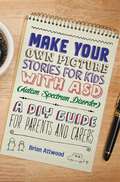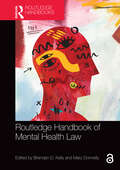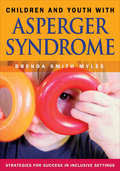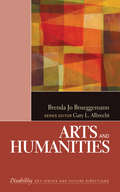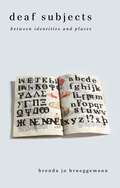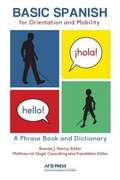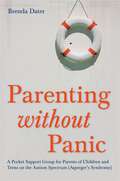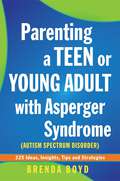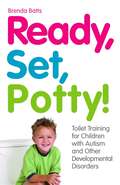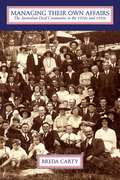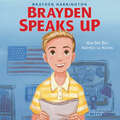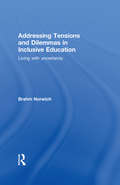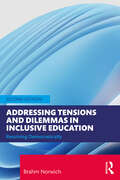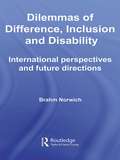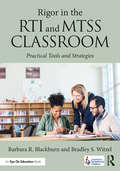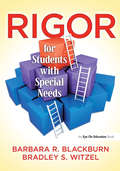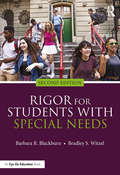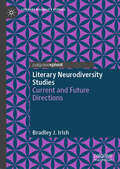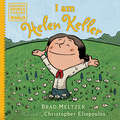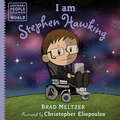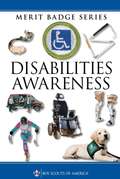- Table View
- List View
Make Your Own Picture Stories for Kids with ASD (Autism Spectrum Disorder): A DIY Guide for Parents and Carers
by Brian AttwoodPicture stories can play a vital role in helping parents negotiate challenging scenarios with kids with ASD. Yet no matter how many books and flashcards you have, they can't cover every eventuality. So, suppose you could draw the stories yourself... Brian Attwood took up pen and paper when his son John's meltdowns became harder to deal with. The effect was immediate and time and time again picture stories have bailed the family out of trouble and saved John from unhappiness and confusion. In this book, Brian describes step-by-step how to create simple yet effective picture stories using basic drawings and short lines of text, and provides examples based on real-life situations for you to adapt for your child. This book will give parents and carers the tools and confidence they need to create individualised picture stories to help their child with ASD cope with social situations, difficult emotions, transitions and other challenging situations.
Routledge Handbook of Mental Health Law (Routledge Handbooks in Law)
by Brendan D. Kelly and Mary DonnellyMental health law is a rapidly evolving area of practice and research, with growing global dimensions. This work reflects the increasing importance of this field, critically discussing key issues of controversy and debate, and providing up-to-date analysis of cutting-edge developments in Africa, Asia, Europe, the Americas, and Australia. This is a timely moment for this book to appear. The United Nations’ Convention on the Rights of Persons with Disabilities (2006) sought to transform the landscape in which mental health law is developed and implemented. This Convention, along with other developments, has, to varying degrees, informed sweeping legislative reforms in many countries around the world. These and other developments are discussed here. Contributors come from a wide range of countries and a variety of academic backgrounds including ethics, law, philosophy, psychiatry, and psychology. Some contributions are also informed by lived experience, whether in person or as family members. The result is a rich, polyphonic, and sometimes discordant account of what mental health law is and what it might be. The Handbook is aimed at mental health scholars and practitioners as well as students of law, human rights, disability studies, and psychiatry, and campaigners and law- and policy-makers.
Routledge Handbook of Mental Health Law (Routledge Handbooks in Law)
by Brendan D. Kelly and Mary DonnellyMental health law is a rapidly evolving area of practice and research, with growing global dimensions. This work reflects the increasing importance of this field, critically discussing key issues of controversy and debate, and providing up-to-date analysis of cutting-edge developments in Africa, Asia, Europe, the Americas, and Australia.This is a timely moment for this book to appear. The United Nations’ Convention on the Rights of Persons with Disabilities (2006) sought to transform the landscape in which mental health law is developed and implemented. This Convention, along with other developments, has, to varying degrees, informed sweeping legislative reforms in many countries around the world. These and other developments are discussed here. Contributors come from a wide range of countries and a variety of academic backgrounds including ethics, law, philosophy, psychiatry, and psychology. Some contributions are also informed by lived experience, whether in person or as family members. The result is a rich, polyphonic, and sometimes discordant account of what mental health law is and what it might be.The Handbook is aimed at mental health scholars and practitioners as well as students of law, human rights, disability studies, and psychiatry, and campaigners and law- and policy-makers.
Children and Youth With Asperger Syndrome: Strategies for Success in Inclusive Settings
by Brenda Smith MylesHow can you make the school year successful for your students with Asperger Syndrome? Asperger syndrome (AS) is a disorder in the autism spectrum, and students with AS suffer from similar, though milder, symptoms as students with autism. Classroom teachers who are responsible for planning for and teaching students with AS generally have not been provided the skills and knowledge to do so. Children and Youth With Asperger Syndrome provides important strategies in teaching children and youth diagnosed with AS. This essential resource for teachers and other educators presents research-based, instructional, behavioral, and environmental strategies for teachers, including: Environmental modifications, including visual supports and organizational strategies Technology accommodations Transition planning Emotional, behavioral, and social supports
Arts and Humanities (The SAGE Reference Series on Disability: Key Issues and Future Directions)
by Brenda Jo BrueggemannThis volume in The SAGE Reference Series on Disability explores the arts and humanities within the lives of people with disabilities. It is one of eight volumes in the cross-disciplinary and issues-based series, which incorporates links from varied fields making up Disability Studies as volumes examine topics central to the lives of individuals with disabilities and their families. With a balance of history, theory, research, and application, specialists set out the findings and implications of research and practice for others whose current or future work involves the care and/or study of those with disabilities, as well as for the disabled themselves. The presentational style (concise and engaging) emphasizes accessibility. Taken individually, each volume sets out the fundamentals of the topic it addresses, accompanied by compiled data and statistics, recommended further readings, a guide to organizations and associations, and other annotated resources, thus providing the ideal introductory platform and gateway for further study. Taken together, the series represents both a survey of major disability issues and a guide to new directions and trends and contemporary resources in the field as a whole.
Deaf Subjects: Between Identities and Places (Cultural Front #12)
by Brenda Jo BrueggemannIn this probing exploration of what it means to be deaf, Brenda Brueggemann goes beyond any simple notion of identity politics to explore the very nature of identity itself. Looking at a variety of cultural texts, she brings her fascination with borders and between-places to expose and enrich our understanding of how deafness embodies itself in the world, in the visual, and in language.Taking on the creation of the modern deaf subject, Brueggemann ranges from the intersections of gender and deafness in the work of photographers Mary and Frances Allen at the turn of the last century, to the state of the field of Deaf Studies at the beginning of our new century. She explores the power and potential of American Sign Language—wedged, as she sees it, between letter-bound language and visual ways of learning—and argues for a rhetorical approach and digital future for ASL literature.The narration of deaf lives through writing becomes a pivot around which to imagine how digital media and documentary can be used to convey deaf life stories. Finally, she expands our notion of diversity within the deaf identity itself, takes on the complex relationship between deaf and hearing people, and offers compelling illustrations of the intertwined, and sometimes knotted, nature of individual and collective identities within Deaf culture.
Basic Spanish for Orientation and Mobility: A Phrase Book and Dictionary
by Brenda J. NaimyProfessionals providing services to people who are visually impaired work with individuals from broadly diverse ethnic, religious, and cultural groups. Many speak languages other than English. Basic Spanish for Orientation and Mobility is a new user-friendly, valuable tool for communicating O&M instruction to students who primarily speak Spanish. This handy and comprehensive manual provides O&M lessons broken down step-by-step and displayed side-by-side in English and Spanish. It also includes phrases and O&M terminology needed to convey instruction, and easy-to-read vocabulary lists
Parenting without Panic: A Pocket Support Group for Parents of Children and Teens on the Autism Spectrum (Asperger's Syndrome)
by Brenda DaterEver wish that parenting a child or teen on the autism spectrum came with instant access to a support group? Brenda Dater has provided parents with exactly that. In this book she draws on her extensive experience as a support group leader and parent of a child on the spectrum to offer trusted advice and tried-and-tested solutions to parents' top concerns, all in an accessible and easy-to-read format. Filled with the voices of other parents in the same situation, the book covers everything from the first steps to take after diagnosis, to advocacy and disclosure, behavior, building independence and resilience, making friends, holidays and vacations, homework, supporting siblings, how to garner support from extended family and friends, and how parents can look after their own wellbeing. This book extends the vital lifeline of a support group to parents of children and teens on the autism spectrum everywhere.
Parenting a Teen or Young Adult with Asperger Syndrome (Autism Spectrum Disorder): 325 Ideas, Insights, Tips and Strategies
by Brenda Boyd325 astute and practical ideas, insights, tips and strategies address the complex issues parents face during this crucial period of transition for their child with Asperger Syndrome (Autism Spectrum Disorder). The practical, bite-size suggestions focus on the vital importance of developing and nurturing an open and healthy relationship with your son or daughter. The easy-to-navigate format will suit busy parents wanting to locate advice to suit their particular needs. All the suggestions are designed to foster understanding and acceptance between family members and help the AS young person with common problem areas such as social vulnerability and peer relationships, self-esteem, anxiety and coping with change. This will be an invaluable companion for parents, carers and family members of an adolescent or young adult with AS.
Ready, Set, Potty!
by Brenda BattsPotty training a child with developmental disorders can be a real challenge, and sometimes the extra difficulties make you feel as though you've tried everything, and failed. In this book, Brenda Batts shows how you can overcome problems, big and small, and provides tried and tested methods that really work, tailored to each individual child. Bursting with ideas on how to see past conventional strategies and adapt toilet training to suit your child, this book outlines methods that have helped even the most despairing of parents and caregivers. Examples of success stories range from two-year-olds to adults aged 20, and show that no matter how difficult it may seem, a little creativity and adaptation can get anyone toilet trained, however many previous attempts have failed. The program itself is supported by plenty of helpful hints and tips, as Brenda covers all you need to get your child past the diaper stage and help them to achieve a big step towards independence. This book is a must for anybody looking to toilet train someone with developmental disorders.
Managing Their Own Affairs: The Australian Deaf Community In The 1920s And 1930s
by Breda CartyManaging Their Own Affairs explores how Deaf organizations and institutions were forged in Australia during the early 20th century. During this period, deaf people challenged the authority of the dominant welfare organizations, or Deaf Societies, which were largely controlled by hearing people and run as charitable institutions. Breda Carty comprehensively documents the growth of the Australian Deaf community and Australian Deaf organizations for the first time. She focuses on both the political developments of the early 20th century and on the nature of the relationships between deaf and hearing people. During this time, deaf Australians aspired to manage their own affairs. They enjoyed some success by establishing “breakaways” from the Deaf Societies, and they also established an independent national organization, which was contested and ultimately suppressed by the Deaf Societies. These developments were influenced by wider social movements in Australian society, such as the mobilization of minority groups in their push for autonomy and equal rights. Although most of the breakaway Deaf organizations did not survive beyond the 1930s, they significantly affected the power structures and relationships between deaf and hearing people in Australia. The Australian Deaf community’s attempts to organize independently during these years have been largely erased from collective memory, making Carty’s examination a particularly important and necessary addition to the historical literature.
Brayden Speaks Up: How One Boy Inspired the Nation
by Brayden HarringtonBrayden Harrington, a thirteen-year-old boy who stutters, gives an incredible speech that electrifies the nation in this timely and extraordinary nonfiction picture book that celebrates the importance of speaking up and using your voice—for everyone deserves to be heard. When Brayden talks, his words get caught in his mouth. He has bumpy speech—and that’s okay! Sometimes, though, he doesn’t feel anyone really understands what it feels like to be a person who stutters.Then Brayden meets Joe Biden, who knows exactly how he feels and inspires him to be more confident. But when Mr. Biden asks Brayden to give a big speech in front of the whole nation, will Brayden be brave enough to speak up and speak out? Brayden Speaks Up is the incredible true story of one extraordinary boy’s perseverance and the importance of celebrating yourself just as you are. For after all, your biggest challenge just might be your greatest gift.
Addressing Tensions and Dilemmas in Inclusive Education: Living with uncertainty
by Brahm NorwichBased on extensive research, Addressing Tensions and Dilemmas in Inclusive Education presents a contemporary and critical analysis of the interaction between different perspectives and positions in the field of inclusive education. Referring to existing attitudes on the education of children and young people with learning difficulties and disabilities, Professor Norwich argues that despite the appeal of inclusion as a single powerful position, its practical realisation involves tensions and dilemmas that have to be addressed and resolved. This core analysis is illustrated by a review of relevant national and international concepts, principles, research and practices drawing on literature in areas of current interest and concern, such as: identification and classification; current national and international conceptions; pedagogic and curriculum issues; organisation of schooling; parental and student perspectives; the contribution of research to policy and practice. Engaging with the fundamental issues in the field and providing a coherent perspective that recognises and justifies the inter-connection between specialised and general school provision, this accessible and timely book will be of interest to all researchers and students of inclusive education.
Addressing Tensions and Dilemmas in Inclusive Education: Resolving Democratically
by Brahm NorwichThis updated second edition of Addressing Tensions and Dilemmas in Inclusive Education further develops the critical analysis of the initial edition that integrates the interaction between different perspectives and positions in the field of inclusive education. This key resource expands the arguments present in the first edition with clearer implications about how to address tensions and dilemmas in inclusive education, and resolve them through democratic deliberation. Based on contemporary research, theory and policy, as well as responding to current perspectives towards the education of children and young people with learning difficulties and disabilities, Brahm Norwich extends and refines the original core argument of the previous edition – the practical realisation of inclusion involves tensions and dilemmas that have to be addressed and resolved. This core analysis focuses on:- identification and classification- current national and international conceptions- pedagogic and curriculum issues- organisation of schooling- parental and student perspectives and the contribution of research to policy and practice.Re-engaging with the fundamental issues in the field and providing a coherent perspective that recognises and justifies the inter-connection between specialised and general school provision, this accessible new edition will be of interest to all students and researchers of inclusive education.
Dilemmas of Difference, Inclusion and Disability: International Perspectives and Future Directions
by Brahm Norwich**Shortlisted for the nasen Special Educational Needs Academic Book award 2008** Inclusion has become very influential internationally in the field of schooling. This has involved the introduction of policies that pursue more provision for, and acceptance of, students with special educational needs or disabilities in ordinary school settings. However, these policies represent different and often conflicting values and approaches to education. The basic dilemma of difference is whether to recognise or not to recognise differences, as either way there are negative implications or risks associated with stigma, devaluation, rejection or denial of relevant opportunities. This is the first book to examine ideas about these dilemmas from a range of disciplines and fields about the nature and origins of such dilemmas as they apply to special and inclusive education. In particular these dilemmas are about: identification – whether to identify students as having special educational needs / disabilities or not? curriculum – how much of a common curriculum is relevant to these students? placement – can appropriate learning can take place in ordinary schools and classes or not? This ground-breaking book examines professional educators and administrators at national and local authority level across three countries – England, USA and the Netherlands – and questions how they recognise tensions or dilemmas in responding to student differences. Of interest to researchers, students, academics and professionals, this study will provide a much needed, balanced and powerful contribution to the inclusion debate.
Rigor in the RTI and MTSS Classroom: Practical Tools and Strategies
by Barbara R. Blackburn Bradley Steven WitzelIn this new book, bestselling author Barbara R. Blackburn and intervention expert Bradley S. Witzel show you how to develop rigorous RTI and MTSS programs that will support students and lead them to lasting success. Written in a clear, engaging style, Rigor in the RTI and MTSS Classroom combines an in-depth discussion of the issues facing at-risk and learning-disabled students with practical strategies for all teachers. You’ll discover how to: Improve academic and social-emotional performance with scaffolding and demonstration of learning techniques; Establish and teach class rules, expectations, and consequences; Use evidence-based activities to spark student discussion; Implement rigorous, research-based strategies for math, literacy, reading, and writing development; Assess student growth and encourage self-reflection. Form an MTSS leadership team to ensure that student needs are met across building and district levels. Each chapter contains anecdotes from schools across the country as well as a variety of ready-to-use tools and activities. Many of the tools are offered as free eResources at www.routledge.com/9781138193383, so you can easily print and distribute them for classroom use.
Rigor for Students with Special Needs
by Bradley S. Witzel Barbara R. BlackburnThis practical, easy-to-read guide explains how to raise the rigor for students with special needs so they can achieve higher levels of learning. Learn how to set clear goals and expectations establish a climate of success scaffold and model lessons use graphic organizers and "think-alouds" apply modifications and accommodations use rigorous questioning strategies differentiate instruction increase family involvement Get even more out of this book by discussing it with others! It’s ideal for study groups and the appendix features a detailed guide on how to make it work for your group! Bonus! You get a great variety of handy black line masters for use in your own classroom.
Rigor for Students with Special Needs
by Bradley S. Witzel Barbara R. BlackburnThis practical guide explains how to raise the rigor for students with special needs so they can achieve higher levels of learning. Bestselling author Barbara R. Blackburn and intervention expert Bradley S. Witzel provide helpful information on assessment, planning, co-teaching models, high expectations, common obstacles, and emphasizing positive outcomes. This second edition offers new, expanded instructional strategies for literacy and math, as well as strategies that work across subject areas. In addition, each chapter is filled with tools and examples to help you implement the ideas. Perfect for general and special educators and supervisors, the book also comes with a study guide so you can collaborate on the book with building or district colleagues. With the practical information in this book, you’ll understand how to teach with higher expectations and rigor so that all students can feel successful.
Literary Neurodiversity Studies: Current and Future Directions (Literary Disability Studies)
by Bradley J. IrishThis book is a concise but comprehensive introduction to the field of literary neurodiversity studies, a growing approach to literary criticism that has emerged in the past decade. Its three parts are designed to: 1) introduce readers both to the general concept of neurodiversity and to current outlooks, approaches, and key scholarship from literary neurodiversity studies; 2) to present one possible vision of the future of literary neurodiversity studies, by offering an argument about how the field might further entwine with more general research on literary cognition, literary emotion, and literary sensation; and 3) to model for readers how one might perform a neurological reading of a literary text, by offering a sustained analysis of Shakespeare’s Othello. It also contains an extensive bibliography of existing scholarship from literary neurodiversity studies, which will provide an indispensable resource for new and experienced researchers in the field.
I am Helen Keller (Ordinary People Change the World)
by Brad MeltzerThe seventh addition to this New York Times bestselling series spotlights Helen Keller and shows kids that obstacles can create heroes (Cover may vary) When Helen Keller was very young, she got a rare disease that made her deaf and blind. Suddenly, she couldn't see or hear at all, and it was hard for her to communicate with anyone. But when she was six years old, she met someone who change her life forever: her teacher, Annie Sullivan. With Miss Sullivan's help, Helen learned how to speak sign language and read Braille. Armed with the ability to express herself, Helen grew up to become a social activist, leading the fight for disabled people and so many other causes.This friendly, fun biography series inspired the PBS Kids TV show Xavier Riddle and the Secret Museum. One great role model at a time, these books encourage kids to dream big. Included in each book are: • A timeline of key events in the hero&’s history • Photos that bring the story more fully to life • Comic-book-style illustrations that are irresistibly adorable • Childhood moments that influenced the hero • Facts that make great conversation-starters • A virtue this person embodies: Helen Keller's resourcefulness was key to her success. You&’ll want to collect each book in this dynamic, informative series!
I am Stephen Hawking (Ordinary People Change the World)
by Brad MeltzerThe groundbreaking physicist and disability advocate is the 34th hero in this New York Times bestselling biography series for ages 5 to 9.From a young age, Stephen Hawking had a strong sense of wonder and was full of questions about the world around him and the stars above. He would spend his whole life trying to figure out how the universe worked, including discovering truths about black holes and energy. And when he was diagnosed with a rare disease called ALS that destroys the nerve cells in the body, he would find his own mental energy to carry on with his studies even after his limbs and vocal chords stopped working. He became one of history's most influential scientists. This friendly, fun biography series inspired the PBS Kids TV show Xavier Riddle and the Secret Museum. One great role model at a time, these books encourage kids to dream big.Included in each book are: A timeline of key events in the hero&’s history Photos that bring the story more fully to life Comic-book-style illustrations that are irresistibly adorableChildhood moments that influenced the hero Facts that make great conversation-starters A virtue this person embodies: Stephen Hawking's perseverance and ability to defy boundaries is highlighted.You&’ll want to collect each book in this dynamic, informative series!
Disabilities Awareness (Merit Badge Series)
by Boy Scouts of America StaffBoy Scouts of America Merit Badge Series: Disabilities Awareness.
BISG Quick Start Guide to Accessible Publishing
by Book Industry Study GroupThe BISG Quick Start Guide to Accessible Publishing offers both a succinct introduction to the basics of accessibility and the market advantages to publishers for adopting best practices in creating accessible digital content. It is available in the EPUB 3 format and serves as a model of a properly accessible publication.<P><P> The guide addresses why and how to create, distribute, and display accessible digital content and provides an overview of these topics:<P> * The critical importance of accessibility<P> * The business case for making content accessible<P> * Practical advice on how best to make content accessible<P> * Legal requirements for accessible content<P> The BISG Quick Start Guide to Accessible Publishing can help companies:<P> * Make content more discoverable<P> * Reach an untapped market<P> * Streamline production workflow<P> * Save money by creating "born accessible" educational materials<P> This is a critical and hopeful time, when technology and massive industry shifts are mitigating the constant catch-up effort that currently limits access and requires so much extra work to create accessible content. With the BISG Quick Start Guide to Accessible Publishing, publishers will discover an invaluable resource. When all digital content is also “born accessible,” the dream of equal access to information for everyone will be a reality.
Anxiety-Free Kids: An Interactive Guide for Parents and Children
by Bonnie ZuckerAnxiety-Free Kids (2nd ed.) offers parents strategies that help children become happy and worry-free, methods that relieve a child's excessive anxieties and phobias, and tools for fostering interaction and family-oriented solutions. Using a unique companion approach that offers two books in one—a practical, reader-friendly book for parents and a fun workbook for kids—this solutions-oriented guide utilizes the cognitive-behavioral approach to therapy and integrates the parent in the child's self-help process.Research has shown that if left untreated, children with anxiety disorders are at higher risk to perform poorly in school, to have less-developed social skills, and to be more vulnerable to substance abuse. Covering the six most commonly occurring anxiety disorders—generalized anxiety, separation anxiety, specific phobias, social phobias, panic disorder, and obsessive-compulsive disorder—this book gives kids and parents successful strategies for achieving relaxation, conquering worries, challenging faulty thinking patterns, developing positive self-talk, and facing one's fears.Educational Resource
